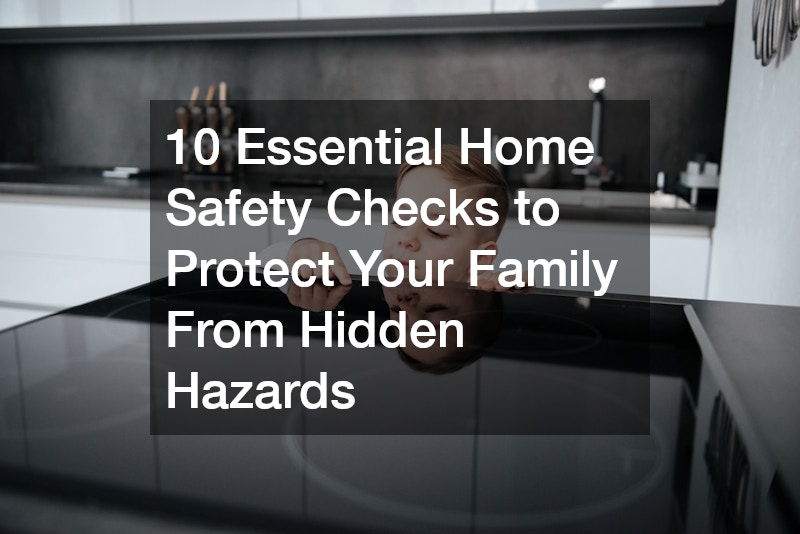To protect your family, you must ensure the safety of your house. Regular home safety assessments will help you identify potential hazards and prevent accidents. This comprehensive guide will cover 10 areas that you should focus on in order to make your home safer and protect your family.
1. Fire Safety: Are You Prepared for the Unexpected?
Prioritising fire safety is essential when conducting a home safety assessment. Check your smoke alarms and detectors to make sure they work properly. Regularly review and practice your fire escape plan with your family to ensure that everyone knows what to expect in the event of a house fire. Electrical cords and wiring should be inspected for signs of wear or damage that could cause a fire. Store flammable materials such as gasoline and cleaning products in a secure and safe location, away from heat sources.
You can reduce the likelihood of an incident involving a fire by proactively addressing your concerns about fire safety in your home. Test your smoke alarms and detectors on a regular basis and replace the batteries when necessary. A well-planned fire escape plan that is communicated to all family members will save valuable seconds in an emergency.
2. Preventing Falls: How Safe Are Your Floors and Stairs?
Falls are the leading cause of injury at home, particularly among older adults and children. Start by securing carpets and rugs that are loose to avoid tripping hazards. Grab bars can be installed in bathrooms, and the lighting in hallways and staircases can improve safety. Avoiding clutter on pathways and arranging furniture in a way to make it easy to navigate can reduce the risk of falling.
You can make your home a safer place for your family by taking proactive measures to prevent accidents. Preventing accidents and injuries by regularly inspecting and securing any loose carpets and rugs can be done. Grab bars are especially useful for people with mobility problems or older adults. They provide stability and support. Lighting in areas with high traffic can make it easier for people to navigate and feel confident, which reduces the risk of accidents.
3. Childproofing: Is Your Home Safe for Little Explorers?
There are many ways to keep your children safe. You should know where the closest pediatric medical facility or dentist is located so that you can get your child checked out in case of an accident as quickly as possible. Safety gates and locks can be installed on cabinets and doors to prevent children from gaining access to potentially dangerous areas—secure heavy appliances and furniture to the wall to prevent accidents. By installing safety latches on cabinets and drawers, you can protect your children from dangerous substances or sharp objects.
Create safe play areas in your home to give children a place where they can play without being exposed to hazards. It is important to supervise children at all times, particularly around dangers like swimming pools and stairs. You can provide a safe environment for your children to explore and thrive by taking proactive measures to childproof your house.
4. Electrical Safety: Are Your Outlets and Wiring Safe?
Electrical safety should be included in your home safety assessment. By regularly inspecting outlets for damage and switches, you can avoid potential hazards. Electrical fires can be reduced by using extension cords in a safe manner. Avoid overloading or running them underneath carpets. Electrical malfunctions can be prevented by understanding how circuit breakers work and not overloading electrical circuits. You can protect yourself and your family by following the best practices in electrical safety.
Prioritise electrical safety when conducting home safety assessments to avoid potential risks. Inspection of outlets and switches can identify problems before they become serious. Look for exposed wires, scorch marks or other signs of damage. Avoid damaging extension cords by only plugging in the recommended number of devices and avoiding tangles. Understanding the circuit breaker and not overloading electrical circuits will help to prevent electrical fires and short circuits.
It is vital to act quickly if you see flickering lights or circuits that have tripped in your home. This will help to prevent any potential dangers. Hire a licensed electrical contractor to examine your home’s wiring and make recommendations on how to improve safety.
5. Door and Window Security: How Protected Is Your Home?
It is important to secure the windows and doors of your house in order to protect your family. You can improve the security of your house by installing deadbolts, security locks and other locking mechanisms at all entry points. Window locks and bars can be used to deter burglars. Glass windows can be reinforced with shatterproof film to prevent forced entry and break-ins. By trimming bushes and installing lighting, you can deter intruders by maintaining visibility around your entry points. To prevent unwanted entry, update your garage door system. Consult your auto insurance agent to confirm your policy’s coverage.
It is important to evaluate the security of your doors and windows during a home safety assessment in order to keep your family safe. Installing security locks and deadbolts on all doors will provide additional protection against forced entry. Window locks and bars can be used on easily accessible windows to prevent burglars from entering your home. By adding shatterproof film to glass windows, you can make it harder for burglars and reduce injuries from broken glass.
Trim bushes and install motion-activated lights to deter intruders. For added security, consider investing in a system with door and window sensors, surveillance cameras, and alarms.
6. Poison Prevention: Are Hazardous Substances Out of Reach?
To prevent poisoning at home, you must take proactive measures to secure dangerous substances and educate your family about poison prevention. Storing medicines in a safe location, out of the reach of pets and children, can help prevent accidental ingestion. Keep household chemicals, such as cleaning agents, locked away to reduce the risk. Carbon monoxide detectors installed in important areas of your home will alert you to dangerous levels. Understanding the effects of common household toxins can help you eliminate poisoning sources in your home.
To protect your family against poisoning, you must plan carefully and pay attention to details during your home security assessments. Storing medicines in a locked cupboard or on a high shelf will prevent pets or children from accidentally accessing them. To prevent accidental ingestion, store household chemicals like bleach, pesticides and detergents in an area with childproof locks. Carbon monoxide detectors installed near sleeping areas or other important locations can alert you to toxic gas accumulation and help prevent carbon monoxide intoxication.
7. Water Damage: Could Leaks Be Threatening Your Home?
If left unchecked, water damage can cause costly repairs and even health risks. Include regular plumbing system inspections for leaks or water damage in your home safety assessment checklist to help you identify problems early. Checking roof leaks and missing tiles can help prevent water from entering your home during heavy rain. Water can be prevented from building up around your house by maintaining gutters and downspouts. Mould and mildew can cause musty odours, discolouration or other signs. This could indicate water damage, which needs to be addressed immediately.
Water damage can be prevented by being proactive in spotting signs of water intrusion or leaks. Check plumbing fixtures such as toilets, faucets and pipes for signs of moisture or leaks. Consult local appliance repair services for an estimate on any necessary upgrades. Roofs with missing or damaged shingles could allow rainwater to enter your home. To prevent flooding, clear debris from gutters.
8. Natural Disasters: Is Your Family Ready for Emergencies?
Preparedness for natural disasters will help you and your family minimise the damage. Prepare an emergency plan that includes emergency contacts, evacuation routes, and essential supplies. Prepare an emergency kit that includes food, water, and first aid supplies. Safeguard important documents like identification cards, insurance policies, and important records with a waterproof, fireproof safe. Consider retrofitting your home to strengthen key areas that are vulnerable in the event of natural disasters like earthquakes and hurricanes.
Prepare your family for natural disasters by taking a proactive and comprehensive approach. Create an emergency plan outlining specific steps you should take for different disaster scenarios. Include evacuation routes and communication protocol. Prepare an emergency kit for every family member with enough food, water and medications to last at least three full days. Keep important documents, like passports, birth certificates, and insurance policies, in a safe and easily accessible place.
9. Air Quality: Are You Breathing Clean Air Indoors?
For a healthy indoor environment, it is important to maintain proper ventilation and air quality. Regularly inspect your HVAC system and replace filters. Air purifiers and humidifiers can be used to remove dust, allergens and excessive humidity. Check for air pollutants like mould, radon, and volatile organic compounds that can impact indoor air quality. By reducing moisture and addressing leaks, you can prevent mould growth.
It is important to manage your home’s ventilation and air quality in order to create a healthy and comfortable living environment for you and your family. Schedule regular maintenance on your HVAC system for optimal performance and circulation of air throughout your home. Air purifiers and humidifiers can help to improve air quality by removing airborne particles.
Regularly assess your home for pollutants like mould, radon and volatile organic compounds. This will help you protect the health of your family and minimise any exposure. Fix leaks and improve ventilation to prevent mould growth. Dehumidifiers can also be used to reduce the moisture in your home. Maintaining proper ventilation and managing the indoor air quality will create a breathable and clean environment for your family.
10. Outdoor Safety: Are Your Garden and Garage Secure?
It is important to secure outdoor spaces around your house in order to maintain privacy and safety. Secure gates and fencing around your property can prevent intruders from entering. You can avoid drowning accidents by securing water features and pools with alarms and safety covers. Installing motion-activated outdoor lighting can increase visibility and deter burglars.
Make sure that garages, sheds and other outdoor structures have secure locks installed to protect valuable items like tools, equipment and bicycles. Consider investing in an outdoor security system that is monitored by a cyber-security company. Assess the risk that your property may be impacted by severe weather. You can find out whether you are eligible for flood insurance by contacting an agency. Take proactive measures to secure your outdoor spaces to create a safe, inviting area for your family.
It is important to protect your family by regularly assessing your home’s safety and taking preventive measures. You can provide a safe and comfortable home for your family by addressing important areas like fire, child, and electrical safety. Stay informed and proactive to protect your family and home from the unexpected.

